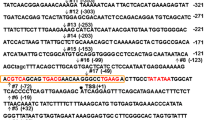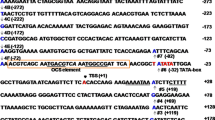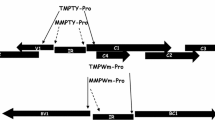Abstract
The boundaries required for maximal expression from the promoter/leader region of the full length transcript of figwort mosaic virus (FLt promoter) coupled to reporter genes were defined by 5′ and 3′ deletion analyses. In transient expression assays using protoplasts of Nicotiana edwardsonii, a 314 bp FLt promoter fragment sequence (−249 to +65 from the transcription start site) was sufficient for strong expression activity. Plant expression vectors developed with modified FLt promoters were tested with GUS or CAT as reporter genes in transgenic plants. The FLt promoter is a strong constitutive promoter, with strength comparable to or greater than that of the CaMV 35S promoter. The FLt promoter with its double enhancer domain linked to GUS or CAT reporter genes provides an average 4- fold greater activity than the FLt promoter with a single enhancer domain (−55 to −249 bp upstream fragment) in tests with transgenic plants and in protoplast transient expression assays
Similar content being viewed by others
References
An, G., Ebert, P.R., Yi, B.Y. and Choi, C-H. (1986) Both TATA box and upstream regions are required for nopaline synthase promoter activity in transformed tobacco cells. Mol. Gen. Genet. 203, 245-50.
An, G., Costa, M.A., Mitra, A., Ha, S.B. and Marton, L. (1988) Organ-specific and developmental regulation of the nopaline synthase promoter in transgenic tobacco plants. Plant Physiol. 88, 547-52.
Assaad, F.F. and Signer, E.R. (1990) Cauliflower mosaic virus P35S promoter activity in Escherichia coli. Mol. Gen. Genet. 223, 517-520.
Baughman, G. and Howell, S.H. (1988) Cauliflower mosaic virus 35S RNA leader region inhibits translation of downstream genes. Virology 167, 125-35.
Benfey, P.N. and Chua, N.H. (1990) The cauliflower mosaic virus 35S promoter: Combinatorial regulation of transcription in plants. Science 250, 959-66.
Benfey, P.N., Ren, L. and Chua, N.H. (1989) The CaMV 35S enhancer contain at least two domains which can confer different developmental and tissue-specific expression patterns. EMBO J. 8, 2195-202.
Benfey, P.N., Ren, L. and Chua, N.H. (1990a) Combinatorial and synergistic properties of CaMV 35S enhancer subdomains. EMBO J. 9, 1685-96.
Benfey, P.N., Ren, L. and Chua, N.H. (1990b) Tissue-specific expression from CaMV 35S enhancer subdomains in early stages of plant development. EMBO J. 9, 1677-84.
Bienz, M. and Pelham, H.R.B. (1986) Heat shock regulatory elements function as an inducible enhancer in the Xenopus hsp 70gene and when linked to a heterologous promoter. Cell 45, 753-60.
Bradford, M.M. (1976) A rapid and sensitive method for the quantitation of microgram quantities of protein utilizing the principle of protein-dye binding. Anal. Biochem. 72, 248-54.
Day Dowson, M.J., Ashurst, J.L., Mathias, S.F., Watts, J.W., Wilson, T.M.A. and Dixon, R.A. (1993) Plant viral leaders influence expression of a reporter gene in tobacco. Plant Mol. Biol. 23, 97-109.
Driesen, M., Benito-Moreno, R.M., Hohn, T. and Futterer, J. (1993) Transcription from the CaMV 19S promoter and autocatalysis of translation from CaMV RNA. Virology 195, 203-10.
Ellis, J.G., Llewellyn, D.J., Walker, J.C., Dennis, E.S. and Peacock, W.J. (1987) The OCS-elements: a 16 base pair palindrome essential for activity of the octopine synthase enhancer. EMBO J. 6, 3203-8.
Fang, R-X., Nagy, F., Sivasubramanian, S. and Chua, N.H. (1989) Multiple cisregulatory elements for maximal expression of the cauliflower mosaic virus 35S promoter in transgenic plants. Plant Cell 1, 141-50.
Fromental, C., Kanno, M., Nomiyama, H. and Chambon, P. (1988) Cooperativity and hierarchical levels of functional organization in the SV 40 enhancer. Cell 54, 943-53.
Gardner, R.C., Howarth, A.J., Hahn, P., Brown-Leudi, M. and Shepherd, R.J. (1981) The complete nucleotide sequence of an infectious clone of cauliflower mosaic virus by M13mp7 shortgun sequencing. Nucl. Acids Res. 9, 2871-88.
Gorman, C.M., Moffat, L.F. and Howard, B.H. (1982) Recombinant genomes which express chloramphenicol acetyltransferase in mammalian cells. Mol. Cell Biol. 2, 1044-51.
Gowda, S., Wu, F.C., Herman, H.B. and Shepherd, R.J. (1989) Gene VI of figwort mosaic virus (caulimovirus group) functions in posttranscriptional expression of genes on the full-length RNA transcript. Proc. Natl Acad. Sci. USA 86, 9203-7.
Guilley, H., Dudley, R.K., Jonard, G., Balazs, E. and Richards, K.E. (1982) Transcription of cauliflower mosaic virus DNA: detection of promoter sequences, and characterization of transcripts. Cell 30, 763-73.
Hasegawa, A., Verver, J., Shimada, A., Saito, M., Goldbach, R., van Kammen, A., Miki, K., Kameya-Iwaki, M. and Hibi, T. (1989) The complete sequence of soybean chlorotic mottle virus DNA and the identification of a novel promoter. Nucl. Acids Res. 17, 9993-10013.
Howell, S.H. and Hull, R. (1978) Replication of cauliflower mosaic virus and transcription of its genome in turnip leaf protoplasts. Virology 86, 468-81.
Hull, R., Sadler, J. and Longstaff, M. (1986) The sequence of carnation etched ring viral DNA: comparison with cauliflower mosaic virus and retroviruses. EMBO J. 5, 3083-90.
Jefferson, R.A., Kananagh, T.A. and Bevan, M.W. (1987) GUS fusion: ·-glucuronidase as a sensitive and versatile gene fusion marker in higher plants. EMBO J. 6, 3901-7.
Kay, R., Chan, R., Daly, M. and McPherson, J. (1987) Duplication of CaMV 35S promoter sequence creats a strong enhancer for plant genes. Science 236, 1299-1302.
Khoury, G. and Gruss, P. (1983) Enhancer elements. Cell 33, 313- 4.
Kiernan, J.M., Wu, F.C., Goldberg, K.B., Gowda, S. and Shepherd, R.J. (1993) Transformation in Nicotiana edwardsonii, In Bajaj, Y.P.S. ed., Biotechnology in Agriculture and Forestry, Vol 22, Plant Protoplasts and Genetic Engineering III, pp. 294-307, Springer-Verlag Berlin Heidelberg.
Lam, E. (1994) Analysis of tissue-specific elements in the CaMV 35S promoter. In Nover, L. ed, Results and Problems in Cell Differentiation, Plant Promoters and transcription factors, Vol 20, pp. 181-96, Springer-Verlag Berlin Heidelberg.
Lam, E. and Chua, N.H. (1989) ASF-2: A factor that binds to the cauliflower mosaic virus 35S promoter and a conserved GATA motif in Cab promoters. Plant Cell 1, 1147-56.
Lam, E., Benfey, P.N., Gilmartin, P.M., Fang, R.X. and Chua, N.H. (1989) Site-specific mutations alter in vitrofactor binding and change promoter expression pattern in transgenic plants. Proc. Natl Acad. Sci. USA 86, 7890-4.
Lawton, M.A., Tierney, M.A., Nakamura, I., Anderson, E., Komeda, Y., Dube, P., Hoffman, N., Fraley, R.T. and Beachy, R.N. (1987) Expression of a soybean 25CF-conglycinin gene under the control of the cauliflower mosaic virus 35S and 19S promoters in transformed petunia tissues. Plant Mol. Biol. 9, 315-24.
Maiti, I.B., Murphy, J.F., Shaw, J.G. and Hunt, A.G. (1993) Plant that express a potyvirus proteinase genes are resistant to virus infection. Proc. Natl Acad. Sci. USA 90, 6110-4.
Medberry, S.L., Lockhart, B.E.L. and Olszewski, N.E. (1992) The commelina yellow mottle virus promoter is a strong promoter in vascular and reproductive tissue. Plant Cell 4: 185-92.
Morelli, G., Nagy, F., Fraley, R.T., Rogers, S.G. and Chua, N.H. (1985) A short conserved sequence is involved in the light inducibility of a gene encoding ribulose-1, 5-bisphosphate carboxylase small subunit of pea. Nature 315, 200-4.
Odell, J.T., Dudley, R.K. and Howell, S.H. (1981) Structure of the 19S RNA transcripts encoded by the cauliflower mosaic virus genome. Virology 111, 377-385.
Odell, J.T., Nagy, F. and Chua, N.H. (1985) Identification of DNA sequence required for activity of the cauliflower mosaic virus Figwort mosaic virus promoter analysis155 35S promoter. Nature 313, 810-2.
Odell, J.T., Knowlton, S., Lin, W. and Mauvais, C.J. (1988) Properties of an isolated transcription stimulating sequence derived from the cauliflower mosaic virus 35S promoter. Plant Mol. Biol. 10, 263-72.
Omirulleh, S., Abraham, M., Golovkin, M., Stefanov, I., Karabaev, M.K., Mustardy, L., Morocz, S. and Dudits, D. (1993) Activity of a chimeric promoter with the double CaMV 35S enhancer elements in protoplast-derived cells and transgenic plants in maize. Plant Mol. Biol. 21, 415-28.
Ondek, B., Gloss, L. and Herr, W. (1988) The SV 40 enhancer contains two distinct levels of organization. Nature 333, 40-5.
Ow, D.W., Jacobs, J.D. and Howell, S.H. (1987) Functional region of the cauliflower mosaic virus 35S RNA promoter determined by the use of the firefly luciferase gene as a reporter of promoter activity. Proc. Natl Acad. Sci. USA 84, 4870-4.
Pobjecky, N., Rosenberg, G.H., Dinter-Gottlieb, G. and Kaufer, N.F. (1990) Expression of the 25CF-glucuronidase gene under the control of the CaMV 35S promoter in Schizosaccharomyces pombe. Mol. Gen. Genet. 220, 314-6.
Richins, R.D. (1993) Organization and expression of the peanut chlorotic streak virus genome. Ph.D. Dissertation, at the University of Kentucky, Lexington, Kentucky, USA.
Richins, R.D., Scholthof, H.B. and Shepherd, R.J. (1987) Sequence of figwort mosaic virus DNA (caulimovirus group). Nucl. Acids Res. 15, 8451-66.
Richins, R.D., Broos, T., Ducasse, D.A., Gowda, S., Mushegian, A.R., Reddy, D.V.R. and Shepherd, R.J. (1994) The complete nucleotide sequence of peanut chlorotic streak virus (PClSV) DNA. EMBL Data Library Gene Bank accession No. U13988.
Sanger, F., Nicklen, S. and Coulson, A.R. (1977) DNA sequencing with chain terminating inhibitors. Proc. Natl Acad. Sci. USA 74, 5463-7.
Sanger, M., Daubert, S. and Goodman, R.M. (1990) Characteristics of a strong promoter from figwort mosaic virus: comparison with the analogous 35S promoter from cauliflower mosaic virus and the regulated mannopine synthase promoter. Plant Mol. Biol. 14, 433-43.
Schardl, C.L., Byrd, A.D., Benzion, G., Altschuler, M.A., Hildebrand, D.F. and Hunt, A.G. (1987) Design and construction of a versatile system for the expression of foreign genes in plants. Gene 61, 1-11.
Schirm, S. and Jiricny, J. and Schaffner, W. (1987) The SV40 enhancer can be dissected into multiple segments, each with a different cell type specificity. Genes. Dev. 1, 65-74.
Scholthof, H.B., Gowda, S., Wu, F. and Shepherd, R.J. (1992) The full-length transcript of a caulimovirus is a polycistronic mRNA whose genes are transactivated by the product of gene VI. J. Virol. 66, 3131-9.
Shepherd, R.J., Richins, R.D., Duffus, J.E., and Handley, M.K. (1987) Figwort mosaic virus: properties of the virus and its adaptation to a new host. Phytopathology 77, 1668-73.
Thomson, D., and Henry, R. (1993) Use of DNA from dry leaves for PCR and RAPD analysis. Plant Mol. Biol. Rep. 11, 202-6.
Author information
Authors and Affiliations
Rights and permissions
About this article
Cite this article
Maiti, I.B., Gowda, S., Kiernan, J. et al. Promoter/leader deletion analysis and plant expression vectors with the figwort mosaic virus (FMV) full length transcript (FLt) promoter containing single or double enhancer domains. Transgenic Res 6, 143–156 (1997). https://doi.org/10.1023/A:1018477705019
Issue Date:
DOI: https://doi.org/10.1023/A:1018477705019




